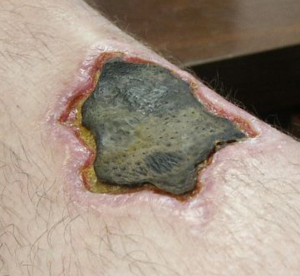Loxoscelism
| Loxoscelism | |
|---|---|
 |
|
| Classification and external resources | |
| Specialty | emergency medicine |
| ICD-10 | T63.3 |
| ICD-9-CM | 989.5 |
Loxoscelism (/ˌlɒkˈsɒsᵻlɪsəm/) is a condition occasionally produced by the bite of the recluse spiders (genus Loxosceles). The area becomes dusky and becomes a deep open sore as the skin around the bite dies (necrosis). It is the only proven type of necrotic arachnidism in humans. While there is no known therapy effective for loxoscelism, there has been research on antibiotics, surgical timing, hyperbaric oxygen, potential antivenoms and vaccines. Because of the number of diseases that may mimic loxoscelism, it is frequently misdiagnosed by physicians.
Loxoscelism was first described in the United States in 1879 in Tennessee. Although there are up to 13 different Loxosceles species in North America (11 native and two nonnative), Loxosceles reclusa is the species most often involved in serious envenomation. Loxosceles reclusa has a limited habitat that includes the Southeast United States. In South America, L. laeta, L. intermedia (found in Brazil and Argentina), and L. gaucho (Brazil) are the three species most often reported to cause necrotic bites.
Loxoscelism may present with local and whole-body symptoms:
Loxosceles venom has several toxins; the most important for necrotic arachnidism is the tissue-destroying agent sphingomyelinase D. It is present in all recluse species to varying degrees and not all are equivalent. This toxin is present in only one other known spider genus (Sicarius). The toxin converts the structural components of the cell membrane into strange ring forms that perhaps act as a trigger for cellular self-destruction.
...
Wikipedia
